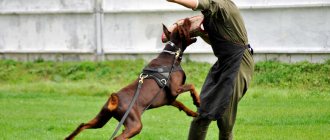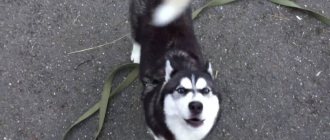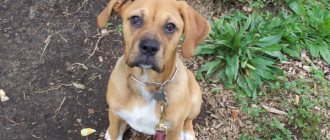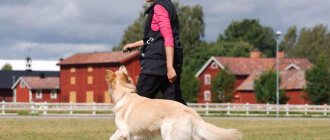Principles of raising a puppy
Puppy training follows the principle “from simple to complex.” If a simple command is poorly understood, then the owner should not move on to a more complicated option. The puppy is not given a whole combination of words at once. All activities should not physically tire your pet. You cannot demand actions that are obviously impossible from him.
Commands are given clearly and always in the same intonation. Dogs primarily respond to human intonation.
Commands are given in one word. You cannot tell your pet to “lie down!”, and then abruptly “lie down!”. When working, unnecessary expressions are unacceptable, such as “lie down, not sit, I said!” The puppy will not understand the owner's requirements and will be confused, as he will receive two different commands at once. Seeing a person’s dissatisfaction and nervousness, the pet itself will become anxious. He will not understand what they want from him and will see that the owner is annoyed with him.
Accustoming to equipment at home
Before the first walk, the puppy must be accustomed to a collar and leash. This will take several days and the owner's patience. A leash is an important attribute of a dog owner. It serves as a means of control and as a means of conveying information to the dog.
The puppy is first introduced to the leash. First, he is shown an object, but at the same time his attention is concentrated on a treat or game. Sometimes the ammunition is simply placed near the bedding or bowl for a while. Thus, the pet understands that the leash does not pose a serious danger.
Next, carefully fasten the collar on the pet. In most cases, the puppy's reaction is expressed by complete disobedience and attempts to get rid of the foreign object. To prevent this from happening, he is distracted with a toy or treat.
If the pet responds adequately to the collar and leash, it is left fastened for some time, but with the possibility of freedom of action. The first time, the equipment is left on the puppy for a few minutes. Every day this time gradually increases.
At home, it is recommended to walk around with your pet on a leash a little so that he begins to get used to the fact that his actions are controlled. He is not given complete freedom. On the first walk, the principle is the same - control of the pet without concessions. Any wrong action can lead to the development of destructive behavior and disobedience on the street.
How to toilet train
After starting to walk the puppy, they immediately begin to teach him how to go to the toilet outside. Now he is prohibited from relieving himself in the house and this must be stopped immediately. The puppy is walked immediately after feeding and waking up from sleep. This way the training will be much more effective. After each need to be relieved on the street, the pet should be immediately praised. By the age of one year, walks are reduced to 2-3 times a day. Accustomed to regular walks, the pet will, if necessary, let the owner know about the desire to relieve itself.
Often, the owner is faced with the fact that the puppy is walking along the street, but at home he immediately goes to the toilet. He is immediately punished and given the command “fu!” To prevent this from happening again, the walking time should be increased. In addition, the owner must control the dog’s actions, because before relieving himself, the pet begins to spin around in search of a suitable place.
Don't delay training your dog!
The biggest mistake is the owner's expectation that the dog will become wiser with age. With age, unwanted elements of behavior can only become entrenched, which are quite difficult to correct in an adult dog. Therefore, it is better to start teaching a dog any commands from the age of three months. Usually by this time the quarantine after vaccinations ends and you can start actively walking with the puppy. At this age, the dog is like plasticine and the owner himself shapes the pet’s behavior in certain conditions. Therefore, if you don’t want to see a behavior in an adult dog, you don’t need to allow it in the puppy either. For example, chasing a cat or another dog, etc.
If a Jack Russell came into the house as a puppy, teenager or adult dog, it’s okay. Give him a couple of days to get used to the new environment, to the intonation of your voice, and feel free to start training.
Weaning the bad habit of picking up food or waste from the ground
Jack Russell Terrier puppies often begin to pick up various unwanted objects from the ground. This becomes a real problem, as the pet runs the risk of severe poisoning. Some owners unsuccessfully try to wean the puppy, or make no effort at all, preferring to put a muzzle on the dog.
To wean the puppy from picking up waste, the puppy is taken to an area where food has been previously supplied. The pet is given the opportunity to explore the area and every time it tries to eat food, the owner gives a prohibitive command and also jerks the leash. If the work does not bring results, then the collar is replaced with a strict one.
Teaching static commands
To me
The very first command with which puppy training begins is “come to me!” The pet must be able to distinguish the owner from strangers and come running when called. The command “come to me!” They also give it when the pet is distracted by strangers.
If the puppy does not respond to the demand, then you absolutely cannot go to him. The owner should pretend to run away or sit down and gently call the puppy. This will arouse curiosity in your pet and provoke him to approach. When following a command, the puppy is praised with a treat. If this method does not bring results, then you need to give the necessary command again and slightly pull the pet towards you with a leash, caress and encourage it.
Place
The second command that needs to be learned is “place!” During training, the puppy should be at the intended location. The owner lures the pet onto the bedding with a treat. Only after the puppy is where he needs to be is he praised and rewarded. The exercise is repeated 5-6 times. The command is carried out without further words, so as not to provoke the dog to leave its place.
Sit
Next, the owner begins to teach the “sit!” command. To do this, the treat is raised above the puppy so that he throws his head back and sits down to improve his visibility. The owner clearly pronounces the command and gives the treat. The exercise is repeated several times. The pet quickly learns the command and after a couple of training sessions it will sit on demand without rewards.
Lie
The command “lie down!” given to the puppy after successfully learning “sit!” The owner holds a treat in his hand and lowers it down, pronouncing a word. When trying to take a treat, the puppy will lie down, but to prevent it from standing up abruptly, the owner must hold it by the collar (or back). The command “lie down!” must be served regardless of whether the pet is standing or sitting. If you only ask a sitting dog to lie down, he will get used to performing exactly this combination of movements.
The Jack Russell Terrier is a hunting breed. He easily picks up a trail and can chase other animals.
You should let your pet off the leash only after he has fully mastered the “come to me!” command.
Basic command training
- home
- Basic command training
My name is
Do you know what word is most pleasant to human hearing? Of course, your own name. For your Jack, his nickname will also become the most favorite word, because its utterance is sure to be followed by some pleasant event. It's best to choose a name for your puppy before you bring him home. When addressing a puppy, call him by his first name only at first, avoiding all sorts of “baby,” “baby,” “handsome,” etc. Call your puppy by name if he turns in your direction, praise him, give him a treat, or start a game. Then move away from him and call again. Give him treats and praise every time he responds to his name. Very soon he will develop a strong association of his own nickname with something pleasant (a treat, a game, praise, a walk, etc.)
Prohibiting command
The most important word you should teach your Jack is the word “NO” (No, Ew, Drop, Ouch, etc.). With this word, you can subsequently designate the puppy’s unwanted behavior and set the boundaries of what is permitted and prohibited. The puppy should associate this word with some kind of negative impact that will follow the command “No!” The impact can be anything. For example, on the street, following the word “No”, you can jerk the leash. If Jack does something prohibited while away from you, you can throw something at him. To do this, you can buy special Fischer discs at the pet store. This is analogous to a bunch of rattling keys, which are quite light, but make a lot of noise.
When teaching a prohibitive command, it is important to offer an alternative activity to replace the one you dislike. For example, Jack stopped gnawing on a chair leg at your command. What's next? He doesn’t know what to do, offer in return some activity that you both will enjoy.
If Jack is near you and you don't like what he's doing, for example, he's tugging at your pants, say “No” and lightly pinch his groin fold - the fold of skin between his back leg and his stomach (it doesn't hurt, but it's quite unpleasant), He will immediately let go of his trousers to see what is pinching there. There is no need to raise your voice and scare him. Very soon Jack will understand that the word “No” is followed by an unpleasant feeling and will stop the activity that is displeasing to the owner. Praise your puppy generously for his obedience and offer him alternative play.
To me!
The second most important command after the prohibiting command. This command will help you avoid a lot of troubles while walking. For example, he set out to chase a cat that interested him across a busy street. Command “Come to me!” will stop him, maybe even save his life. This command can be taught with a treat or a toy. You give the command “Come to me!” and try to attract the attention of your Jack - with your voice, a treat, or the squeak of a toy. When he, interested, approaches you, encourage him, praise him. This could be a game or a treat. Practice the command at home so that Jack carries it out with joyful enthusiasm.
All dogs are divided into “play” and “food” dogs depending on which reward is preferable for them. Some people respond more readily to food, while others respond more readily to toys. Basically, all Jacks are “play” dogs
After this, you can complicate the task and move outside, where there are many distractions. Start giving the command when Jack is on a leash and you have the ability to control him. When the command is carried out unquestioningly with the leash, try to remove it. During your walk, call Jack to you as often as possible with the command “Come to me!”, encouraging him each time.
Static commands
Such commands include “Sit”, “Stand”, “Lie down”. Very useful commands for keeping the dog waiting for a while. For example, you come home from a walk with Jack and he needs to wash his paws. But first of all, you need to undress yourself. To prevent Jack from dirtying your entire apartment, you give him the command “Lie down” and “Wait.” At this time, you calmly undress, go, turn on the water in the bathroom, and only then call the dog.
The easiest command for dogs to learn is “Sit”. However, if you show your pet at shows, first teach him the “Stand” command, so that in the ring Jack does not try to sit down at the slightest opportunity, but stands calmly.
"Sit"
Stand in front of Jack, take the treat in your hand and lift it above his eye level. When he lifts his head to look at the treat, use your free hand to press down on his rump so that Jack sits up. When he sits, give the command "Sit", praise him and give him a treat. Repeat the exercise several times.
"Lie"
Jack is in a sitting position. You bring your hand with a treat to his nose and gradually lower your hand down and slightly forward. The puppy will reach for the hand and assume a lying position. Then give the command “Lie down”, praise him and treat him with a treat.
"Stand"
Use a leash or any other method to make Jack stand. Then give the command “Stand”, praise him and give him a treat.
"Wait"
After teaching Jack static commands, train him to stay in one position for as long as needed there. For example, give the command “Sit,” after Jack sits, reward him, then take a couple of steps away from him while saying “Wait.” If he remains sitting, return to him and give him a treat. If he stands behind you, return him to his original position, without reward. Increase the distance you move away gradually. Then try to go into another room.
Jack must be sure that you will return to him and praise him, no matter how much time you are absent.
Try executing the “Wait” command on the street, where there are a lot of interesting and distracting things.
We have provided the simplest and most useful commands that will come in handy in everyday life. However, you can expand the list yourself; it is a matter of your personal imagination.
Jackies love exercise and are able to learn many commands and different tricks.
Go ahead, have fun, both you and your Jack!
Weaning off unnecessary barking
Barking is one of the methods of communication in dogs. They express their emotions and intentions to them. The timbre of the bark changes depending on the dog's condition. To eliminate unreasonable vocalization, you need to understand in what cases your pet begins to bark and adhere to certain rules:
- do not use the deny command (it is useless);
- do not praise the dog when it barks (even when fulfilling another requirement);
- do not punish the dog using physical violence;
- do not provoke the dog to bark.
The best option is a distraction maneuver. As soon as the pet gives a voice, the owner tells him the command “come to me!” and waits for it to be completed. If the puppy does not respond, then the demand is repeated, but in a slightly threatening tone. By being distracted by its implementation, the pet stops unwanted barking.
Most often, burrowing breeds have a tendency to bark for no reason. This occurs in Fox Terriers and Jack Russell Terriers. During the hunt, their task was not only to chase the prey, but also to bark at it before catching it.
Training a Jack Russell Terrier puppy in
When you turn to our dog training center for help in training a Jack Russell terrier puppy, you can be sure that a real specialist in his field
and will provide training at the proper, highest level.
- A dog trainer will come to your
home at a time convenient for you. - Classes are held 1-2 times a week
, depending on the program. - Instructors work from 9:00 to 21:00
, on weekends inclusive - The training program is drawn up at the first lesson,
taking into account the breed, age, personal characteristics of the dog and your wishes for training - Some classes take place at home
, some
outside
, depending on the topic of the lesson. - Puppy age
from 2 months
Our Center employs dog handlers - animal psychologists who have experience in working with Jack Russell Terrier puppies and training adult dogs from 10 to 35 years old, who know all the nuances of their behavior
and features of training at each stage of a dog’s growth. Therefore, your pet is guaranteed to learn to carry out your commands the first time in any conditions, and will become your faithful and reliable companion.
Common mistakes at home
Mistakes are usually made by inexperienced owners. Any dog needs to be trained, regardless of breed and size. Mistakes make it difficult to work with your pet and can lead to unwanted reflexes. All erroneous actions are based on a misunderstanding of dog behavior and a lack of basic training skills.
The biggest mistake is to evaluate a pet’s behavior as human. This is fraught with the fact that during training the dog begins to receive demands that it cannot fulfill. Accordingly, if this is not done, the owner uses physical violence, which develops fear of humans in the pet.
Excessive physical and mental stress leads to nervousness and fatigue in the dog. A tired pet stops following commands and generally responding to them. Therefore, the owner must draw up a training program in advance and include regular breaks in it.
Recommendations from experts on how to train
For successful training, dog experts have developed a special method of training dogs. They recommend conducting all classes in a calm environment so that the puppy is not distracted by extraneous stimuli. Training should take place throughout the day, but with regular breaks so as not to tire the pet. Only the dog owner is involved in the work. This situation should not be allowed when training is carried out by a stranger.
Experienced Jack Russell Terrier breeders advise devoting a lot of time to raising and training your pet from puppyhood. They can be carried out from 2-3 months, but some start classes from 1.5 months. As they grow older, the load increases, since representatives of this breed have a large supply of energy.
Character and temperament
Many dog breeders consider this breed to be the most active and energetic in the world, and also prone to adventure. At the same time, “Russells” strive for dominance and are very cunning. They quickly “feel” for the owner’s weak points and sometimes show themselves to be real manipulators.
An active and self-confident owner will suit them, who will be able to provide the dog with a long walk with jogging or outdoor games on the training ground, and at the same time become a real leader for him. This breed is not suitable for homebodies and lovers of silence: if the dog does not give his best during walks, his behavior will become destructive and aggressive, to the point that the dog will bite. Since the breed was originally a hunting breed, the attitude towards other animals without socialization will be sharply hostile.
We recommend this article:
Is it possible to take a Jack Russell Terrier with you hunting?
However, it cannot be said that the Jack Russell Terrier is categorically not recommended for beginners: it is a medium-sized breed, and even a problem dog is unlikely to be fatal to humans, even if it starts to bite (although such behavior, of course, must be categorically prevented). If you want to try your hand, stick to the rules and enlist the help of a trainer. If you raise your dog correctly, he will delight you with his sociability, friendliness and excellent learning speed.











